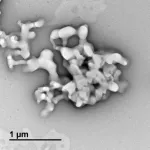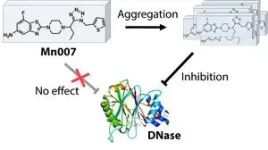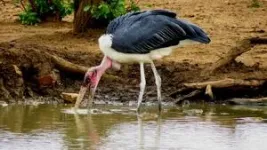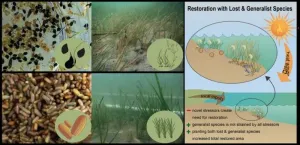(Press-News.org) An entirely new approach to inhibiting DNA-cleaving enzymes works through the aggregation of an otherwise non-toxic molecule. This Kobe University discovery may lead to a much-needed method for curbing Streptococcus growth.
Enzymes are the body’s tools to make almost all reactions happen. But the same is true for bacteria like Streptococcus, which causes toxic shock syndrome, a rapidly progressing and deadly condition. When the body’s white blood cells try to capture the bacteria by casting nets made out of their own DNA, Streptococcus uses a DNA-cleaving enzyme to cut through the net. Blocking this enzyme has been a hot target for the development of drugs for the fight against the disease, but nothing has been found that is specific to the DNA-cleaving enzyme and that doesn’t harm the body in other ways.
Kobe University biochemical engineer MARUYAMA Tatsuo thinks he and his team may have found an approach. While doing research on a drug called “Mn007,” they noticed that it had the ability to inhibit a bovine DNA-cleaving enzyme that is functionally very similar to the one used by Streptococcus. Maruyama explains: “It was a coincidence, but we discovered that only aggregates (“clumps”) of Mn007 inhibit the enzyme. This is a completely new mechanism for inhibition and so we decided to investigate if this might be a promising candidate for the treatment of streptococcal infections.”
Their results, published in the journal JACS Au, are promising and curious. They first confirmed that it is really only aggregates that inhibit the enzyme, that the action is specific to this particular DNA-cleaving enzyme, and that it is not mediated by interaction with the DNA or other substances. Next, the Kobe University team made sure that Mn007 could also inhibit the bacterial enzyme. And finally, they tried whether this could, in principle, be applied to Streptococcus infections. Knowing from previous studies that Mn007 is not toxic to the body’s cells, they grew the bacteria in human blood containing white blood cells and added Mn007 to some of the samples. And indeed, when the drug was present, the bacteria showed significantly less growth than without it, indicating that aggregates of Mn007 helped the white blood cells reign in the bacteria’s growth.
These lab studies open an exciting door to further research. First, even though they discovered a completely new mechanism of inhibiting the activity of the DNA-cleaving enzyme, also called a “DNase,” nobody knows yet what this mechanism behind the specific inhibition by the aggregates is. Maruyama says, “Currently, the research group is trying to understand how Mn007 aggregates interact with the DNase and inhibit its enzymatic activity by simulating the behavior of the molecule.”
But a bigger question looms on the horizon: whether the drug can actually be applied as an effective treatment. The researchers write hopefully: “Mn007 would be the first case of a DNase inhibitor applied for therapeutic use. Because Streptococcus pyogenes infections worsen rapidly (within a few days), even temporary suppression of bacterial growth would significantly improve patient outcomes.” They close by saying, “We believe that molecular aggregation will provide a rational approach for the discovery and development of novel inhibitors for those enzymes, leading to a new strategy in drug development.”
This research was funded by the Japan Society for the Promotion of Science (grants 19H05458, 23H01774, 21K14471, 21H02885, 23H02634), the Japan Agency for Medical Research and Development (grants JP24ek0109691, JP22bm0804028h0002, JP23fk0108675, JP23fk0108607, JP23wm0325037, JP23gm1610013), the Nakatani Foundation for Advancement of Measuring Technologies in Biomedical Engineering (grant 2022S230), and the Toyota Physical and Chemical Research Institute. It was conducted in collaboration with researchers from Fujita Health University and Nagoya City University.
Kobe University is a national university with roots dating back to the Kobe Commercial School founded in 1902. It is now one of Japan’s leading comprehensive research universities with nearly 16,000 students and nearly 1,700 faculty in 10 faculties and schools and 15 graduate schools. Combining the social and natural sciences to cultivate leaders with an interdisciplinary perspective, Kobe University creates knowledge and fosters innovation to address society’s challenges.
END
Clumps of this molecule inhibit strep’s DNA-cleaving enzymes
2024-04-30
ELSE PRESS RELEASES FROM THIS DATE:
Cars as particles
2024-04-30
What do the flow of cars on a highway and the movement of bacteria towards a food source have in common? In both cases, annoying traffic jams can form. Especially for cars, we might want to understand how to avoid them, but perhaps we've never thought of turning to statistical physics, as Alexandre Solon, a physicist from Sorbonne Université, and Eric Bertin, from the University of Grenoble, both working for the Centre national de la recherche scientifique CNRS, have done. Their research, recently published in the Journal of Statistical Mechanics: Theory and Experiment (JSTAT), has developed a one-dimensional mathematical model ...
Let widgeongrass be a weed in the seagrass yard -- making seagrass restoration more resistant to rising temperatures using generalist grasses
2024-04-30
New research demonstrates that seagrass habitat restoration can be enhanced by including other grasses in addition to the declining or lost species and – ultimately – that restoration efforts must proactively select species that can withstand current and intensifying stressors driven by human activities and climate change.
Rising global temperatures combined with centuries of humans working within our seascapes has reshaped coastal ecosystems. Rebuilding or restoring coastal habitat is becoming ...
Group sales incentives boost weak brand sales, study finds
2024-04-30
New research co-authored by a UC Riverside business professor provides some sound advice for managers of retail outlets that limit their product selection to a particular brand: Managers should factor in the strength of their brand when structuring the pay incentives for their sales staff.
The study focused on what marketing scholars call “brand-managed” retail operations. These outlets include “stores within stores,” such as counters in major department stores with dedicated sales staff that offer just one brand of cosmetics such as Clinique. They can also be stores ...
The double-fanged adolescence of saber-toothed cats
2024-04-30
The fearsome, saber-like teeth of Smilodon fatalis — California's state fossil — are familiar to anyone who has ever visited Los Angeles' La Brea Tar Pits, a sticky trap from which more than 2,000 saber-toothed cat skulls have been excavated over more than a century.
Though few of the recovered skulls had sabers attached, a handful exhibited a peculiar feature: the tooth socket for the saber was occupied by two teeth, with the permanent tooth slotted into a groove in the baby tooth.
Paleontologist Jack Tseng, associate professor of integrative biology at the University of California, Berkeley, doesn't think the double fangs ...
COVID-19-induced financial hardships reveal mental health struggles
2024-04-30
When COVID-19 caused significant economic disruptions, thousands of people around the world experienced sudden shocks to their financial situation through reduced earnings or job losses.
Now economic researchers at the University of South Australia have examined the mental health effects on people who experienced immediate or expected financial setbacks during the height of the pandemic.
Data gathered from China, Japan and South Korea during the early phases of the pandemic revealed that the severe economic shocks induced by COVID-19 caused significant ...
Healthy lifestyle may offset effects of life-shortening genes by 60%+
2024-04-30
A healthy lifestyle may offset the effects of life-shortening genes by more than 60%, suggests an analysis of the findings from several large long term studies, published online in the journal BMJ Evidence Based Medicine.
While genes and lifestyle seem to have an additive effect on a person’s lifespan, an unhealthy lifestyle is independently linked to a 78% heightened risk of dying before one’s time, regardless of genetic predisposition, the research indicates.
The polygenic risk score (PRS) combines ...
Frequent teen vaping might boost risk of toxic lead and uranium exposure
2024-04-30
Frequent teen vaping might boost the risk of exposure to lead and uranium, potentially harming brain and organ development, suggests research published online in the journal Tobacco Control.
The findings underscore the need for implementation of regulations and prevention efforts targeting teens, emphasise the researchers.
Vaping is popular with teens. In 2022, an estimated 14% of US high school students—around 2.14 million—and more than 3% of middle school students—around 380,000—reported vaping in the preceding month, note the researchers.
Certain metals have been identified in e-cigarette aerosols and ...
Fentanyl inhalation may cause potentially irreversible brain damage, warn doctors
2024-04-30
Inhaling the synthetic opioid fentanyl may cause potentially irreversible brain damage (toxic leukoencephalopathy), warn doctors in the journal BMJ Case Reports, after treating a middle aged man found unresponsive in his hotel room after snorting the drug.
Leukoencephalopathy refers to inflammation and damage to the brain’s white matter—the network of nerve fibres that enable the exchange of information and communication between different areas of the brain’s grey matter.
Toxic leukoencephalopathy is a sudden or longstanding neurological syndrome, which ...
OHSU patient is world’s first documented case of brain disease from fentanyl inhalation
2024-04-30
The man arrived unconscious and near death.
Previously healthy with no known medical history, the 47-year-old arrived by ambulance to the emergency department at Oregon Health & Science University on Feb. 25, 2023. He was found collapsed in his hotel room, where he was staying during a business trip. As clinicians began administering life-saving treatment, they searched for the cause.
In a case report published online today in the journal BMJ Case Reports, clinicians laid out the surprising and unprecedented diagnosis: toxic ...
Microarray patches safe and effective for vaccinating children, trial shows
2024-04-30
EMBARGOED UNTIL 23:30 UK TIME MONDAY 29 APRIL 2024
Peer-reviewed/Randomised Control Trial/Humans
The phase 1/2 randomized trial compared results from the measles and rubella vaccine delivered by a microarray patch, a small sticking plaster-like device with an array of microscopic projections that painlessly penetrate the skin and deliver the vaccine, or by conventional injection with a needle and syringe.
The trial, which involved 45 adults (18-40 years old), 120 toddlers (15-18 months old) and 120 infants (9-10 months old) in The Gambia, ...






